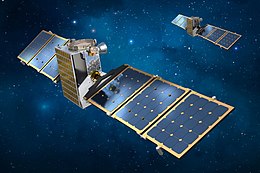
The Explorers program is a NASA exploration program that provides flight opportunities for physics, geophysics, heliophysics, and astrophysics investigations from space. Launched in 1958, Explorer 1 was the first spacecraft of the United States to achieve orbit. Over 90 space missions have been launched since. Starting with Explorer 6, it has been operated by NASA, with regular collaboration with a variety of other institutions, including many international partners.
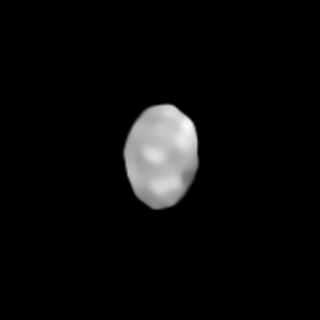
16 Psyche is a large M-type asteroid, which was discovered by the Italian astronomer Annibale de Gasparis, on 17 March 1852 and named after the Greek goddess Psyche.

The Discovery Program is a series of Solar System exploration missions funded by the U.S. National Aeronautics and Space Administration (NASA) through its Planetary Missions Program Office. The cost of each mission is capped at a lower level than missions from NASA's New Frontiers or Flagship Programs. As a result, Discovery missions tend to be more focused on a specific scientific goal rather than serving a general purpose.

65803 Didymos is a sub-kilometer asteroid and binary system that is classified as a potentially hazardous asteroid and near-Earth object of the Apollo group. The asteroid was discovered in 1996 by the Spacewatch survey at Kitt Peak, and its small 160-meter minor-planet moon, named Dimorphos, was discovered in 2003. Due to its binary nature, the asteroid was then named Didymos, the Greek word for 'twin'.
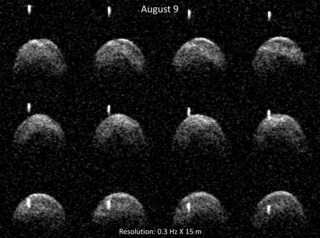
(35107) 1991 VH is a binary near-Earth asteroid and potentially hazardous asteroid of the Apollo group. It was discovered on 9 November 1991, by Australian astronomer Robert McNaught at Siding Spring Observatory. This binary system is composed of a roughly-spheroidal primary body about one kilometre in diameter, and an elongated natural satellite less than half a kilometre in diameter. The 1991 VH system is unusual for its dynamically excited state; the satellite has a tumbling, non-synchronous rotation that chaotically exchanges energy and angular momentum with its precessing, eccentric orbit. This asteroid system was one of the two targets of NASA's upcoming Janus Mayhem mission, until the delay of the rocket launch made both targets inaccessible.

(175706) 1996 FG3 is a carbonaceous asteroid and binary system, classified as near-Earth object and potentially hazardous asteroid of the Apollo group, approximately 1.7 kilometers (1.1 miles) in diameter. The primary has a spheroidal shape. Its minor-planet moon measures approximately 490 meters (1,600 feet) in diameter.
The Asteroid Impact and Deflection Assessment (AIDA) missions are a proposed pair of space probes which will study and demonstrate the kinetic effects of crashing an impactor spacecraft into an asteroid moon. The mission is intended to test and validate impact models of whether a spacecraft could successfully deflect an asteroid on a collision course with Earth.

VERITAS is an upcoming mission from NASA's Jet Propulsion Laboratory (JPL) to map the surface of the planet Venus in high resolution. The combination of topography, near-infrared spectroscopy, and radar image data will provide knowledge of Venus's tectonic and impact history, gravity, geochemistry, the timing and mechanisms of volcanic resurfacing, and the mantle processes responsible for them.

Psyche is a NASA Discovery Program space mission launched on October 13, 2023, to explore the origin of planetary cores by orbiting and studying the metallic asteroid 16 Psyche beginning in 2029. NASA's Jet Propulsion Laboratory (JPL) manages the project.
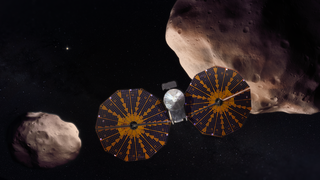
Lucy is a NASA space probe on a twelve-year journey to eight different asteroids. It is slated to visit two main belt asteroids as well as six Jupiter trojans – asteroids that share Jupiter's orbit around the Sun, orbiting either ahead of or behind the planet. All target encounters will be flyby encounters. The Lucy spacecraft is the centerpiece of a US$981 million mission. It was launched on 16 October 2021.
The selection process for Mission 13 and 14 of the Discovery program began in February 2014, as NASA drafted an Announcement of Opportunity (AO) for the next Discovery mission. The winning mission proposals received $450 million in funding towards mission development and construction, along with bonus funding if missions were able to incorporate certain technologies. For Discovery Mission 13 and 14, NASA received 28 proposals, 16 of which notably centered around small Solar System bodies. Lucy, a multiple-flyby mission to the Jupiter trojans, and Psyche, a mission to the metallic asteroid 16 Psyche, were announced as the winners of the competition in January 2017, with launches in October 2021 and October 2023, respectively.
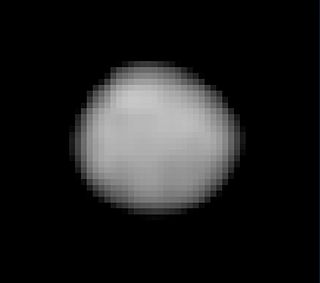
Athena was a proposed space mission that would have performed a single flyby of asteroid 2 Pallas, the third largest asteroid in the Solar System.

Dimorphos is a natural satellite or moon of the near-Earth asteroid 65803 Didymos, with which it forms a binary system. The moon was discovered on 20 November 2003 by Petr Pravec in collaboration with other astronomers worldwide. Dimorphos has a diameter of 177 meters (581 ft) across its longest extent and it was the target of the Double Asteroid Redirection Test (DART), a NASA space mission that deliberately collided a spacecraft with the moon on 26 September 2022 to alter its orbit around Didymos. Before the impact by DART, Dimorphos had a shape of an oblate spheroid with a surface covered in boulders but virtually no craters. The moon is thought to have formed when Didymos shed its mass due to its rapid rotation, which formed an orbiting ring of debris that conglomerated into a low-density rubble pile that became Dimorphos today.

Shannon Curry is a planetary physicist and the Principal Investigator of the NASA Mars Scout mission MAVEN. Dr. Curry is an Associate Professor at the University of Colorado, Boulder in the Astrophysics and Planetary Sciences (APS) Department as well as a researcher at the Laboratory for Atmospheric and Space Physics (LASP). Prior to this, she served as the Deputy Assistant Director of Planetary Science at the Space Sciences Laboratory at the University of California, Berkeley.

Small Innovative Missions for Planetary Exploration (SIMPLEx) is a planetary exploration program operated by NASA. The program funds small, low-cost spacecraft for stand-alone planetary exploration missions. These spacecraft are intended to launch as secondary payloads on other missions and are riskier than Discovery or New Frontiers missions.

Hera is a spacecraft developed by the European Space Agency for its space safety program. Its primary mission objective is to study the Didymos binary asteroid system that was impacted four years earlier by the NASA Double Asteroid Redirection Test (DART) spacecraft and contribute to validation of the kinetic impact method to deviate a near-Earth asteroid from a colliding trajectory with Earth. It will measure the size and morphology of the crater created as well as the momentum transferred by an artificial projectile impacting an asteroid, which will allow measuring the efficiency of the deflection produced by the impact. It will also analyze the expanding debris cloud caused by the impact.
